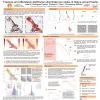Poster #148, Fault and Rupture Mechanics (FARM)
Viscoelastic earthquake sequence simulations in complex geometries
Poster Image:

Poster Presentation
2020 SCEC Annual Meeting, Poster #148, SCEC Contribution #10365 VIEW PDF
namic problem with explicit time steps in the coseismic phase and the quasi-static problem with adaptive time steps in the interseismic phase, as in Duru et al. (2019). We account for spatially variable material properties, power-law viscoelasticity, and complex geometries. Target applications of our method include earthquake sequences on rough faults, dipping faults, and branching faults. Viscoelasticity relaxes stress concentrations during the interseismic period, thereby allowing us to load complex fault systems by displacing the remote boundaries instead of utilizing the backslip approximation. In addition, by coupling to the acoustic wave equation for velocity potential in an overlying ocean layer, and accounting for gravity following Lotto and Dunham (2105), we will be able to simulate earthquake and tsunami histories for offshore faults.
SHOW MORE
SHOW MORE
























































